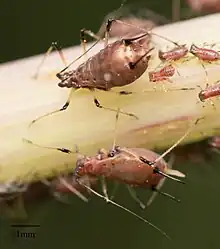| Uroleucon sonchi | |
|---|---|
 | |
| Scientific classification | |
| Domain: | Eukaryota |
| Kingdom: | Animalia |
| Phylum: | Arthropoda |
| Class: | Insecta |
| Order: | Hemiptera |
| Suborder: | Sternorrhyncha |
| Family: | Aphididae |
| Genus: | Uroleucon |
| Species: | U. sonchi |
| Binomial name | |
| Uroleucon sonchi (Linnaeus, 1767) | |
Uroleucon sonchi is a species of aphid in the family Aphididae. Known as the large sow-thistle aphid, it is a native of Europe, and has been introduced to several other countries.[1][2][3][4] It principally feeds on the sow thistle (Sonchus sp.) but is also a pest of cultivated lettuce, and so is also known as the brown lettuce aphid.[5]
Distribution
U. sonchi is native to the Palaearctic region, but is now found in North and South America, the Middle East, Yemen, Africa, India, Japan, China, Korea, New Zealand, and (since 1995) Australia.[6]
Ecology
This species feeds on many plants in the Asteraceae, mostly the tribe Lactuceae: sow-thistle (Sonchus oleraceus) and other Sonchus species, lettuce and other Lactuca species, endive, Emilia sonchifolia, Geropogon glabrum, and Picris hieracioides.[6]
Parasites
The parasite Aphidius sonchi, ostensibly a specialised parasite of Hyperomyzus lactucae, has been reared occasionaly from U. sonchi.[6]
Subspecies
These three subspecies belong to the species Uroleucon sonchi:
- Uroleucon sonchi afghanicum (Narzikulov & Umarov, 1972)
- Uroleucon sonchi sonchi (Linnaeus, 1767)
- Uroleucon sonchi stepposa
References
- ↑ "Uroleucon sonchi Report". Integrated Taxonomic Information System. Retrieved 2019-09-24.
- ↑ "Uroleucon sonchi". GBIF. Retrieved 2019-09-24.
- ↑ "Uroleucon sonchi species Information". BugGuide.net. Retrieved 2019-09-24.
- ↑ Favret, Colin (2019). "species Uroleucon sonchi (Linnaeus, 1767)". Aphid species file online, Version 5.0. Retrieved 2019-07-02.
- ↑ Reinink, K.; Dieleman, F. L. (1989). "Resistance in lettuce to the leaf aphids Macrosiphum euphorbiae and Uroleucon sonchi". Annals of Applied Biology. 115 (3): 489–498.
- 1 2 3 Carver, Mary (1999). "Uroleucon sonchi (Linnaeus) (Hemiptera: Aphididae) in Australia". Australian Journal of Entomology. 38 (4): 314–317.
External links
 Media related to Uroleucon sonchi at Wikimedia Commons
Media related to Uroleucon sonchi at Wikimedia Commons